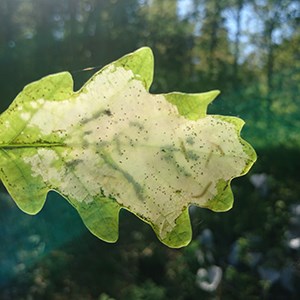Oaks leafing out early in spring escape attacks from a picky moth

The day when oaks leaf out can have a big impact on outbreak levels of the brown oak slender moth. If trees pick the wrong time, they can become so infested that there is little space for other insect herbivores to colonize the oaks, according to a Finnish–Swedish research team. As timing of leaf out is temperature sensitive, the researchers believe that spring weather can determine both moth outbreak levels and infestation by other herbivore species. The new work will help us understand how plants and insects are responding to a warmer climate.
In Sweden, oaks in the region of Mälardalen have been under severe attack from an insect herbivore called the brown oak slender moth. This is a tiny moth that spends its larval stage inside oak leaves. The larvae can be spotted on oak leaves in late May, just after leaf out in oaks. By eating the nutritious leaf tissue, it creates characteristic pockets inside the leaf, called mines. Usually, the moth only consumes a part of the leaf. But in outbreak areas, several larvae can attack and consume the entire leaf. The causes of these outbreaks were unknown, but now a research group from Sweden and Finland shed light on this mystery.
– It seems like oaks that leaf out early in spring can escape infestation of the brown oak slender moth. Leaves loose nutritional value over time, so leaves on oaks that leaf out early in spring are old and distasteful by the time moths become active, says Adam Ekholm, PhD-student at the Swedish University of Agricultural Sciences.
In their experiment, the researchers exposed two sets of potted oak trees, which differed by 20 days in leaf out, to an area rich in the brown oak slender moth. Of the two sets, oaks with an early leaf out only had just a few percent of their leaves infested, while oaks with a late leaf out had up to 93 % of their leaves infested by the moth.
– This dramatic difference in infestation also left an imprint on other species of insect herbivores colonizing the oak. Since the brown oak slender moth infest oaks shortly after leaf out, they don’t leave much space for other species that colonizes the oak later in the season. For those species that do colonize infested oaks, they will most likely encounter full-grown larvae that can predate on the smaller, less developed larvae, says Ayco Tack, Associate Professor at Stockholm University.
As both leaf out and insect activity are sensitive to temperature, changes in the climate can modify the interaction between the oak and the brown oak slender moth.
– It is difficult to predict whether oaks will be subject to higher or lower outbreak levels in the future. Warmer temperatures can advance the activity of both oaks and moths. If oaks are more heavily attacked by herbivores, then this could result in reduced oak growth and in a lower diversity of insects on oak trees. But it is still unlikely that the moth will actually kill the oaks, says Tomas Roslin, Professor at the Swedish University of Agricultural Sciences.
Scientific article
Host plant phenology, insect outbreaks and herbivore communities – The importance of timing, Ekholm et al, Journal of Animal Ecology
https://onlinelibrary.wiley.com/doi/10.1111/een.12719
Contact
Adam Ekholm, PhD
Department of Ecology
+4618671930, adam.ekholm@slu.se
Dissertation
Adam Ekholm defended his thesis ”Seasonal interactions between oaks and insects – Evolutionary adaptations and predictions for climate change” on the 20th of May.